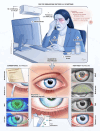Dry Eye Disease: From Causes to Patient Care and Clinical Collaboration-A Narrative Review
- PMID: 40434534
- PMCID: PMC12167426
- DOI: 10.1007/s40123-025-01161-8
Dry Eye Disease: From Causes to Patient Care and Clinical Collaboration-A Narrative Review
Abstract
Dry eye disease (DED) is a common condition of the ocular surface that affects tens of millions of people worldwide. It is often characterized by decreased tear production or increased evaporation, resulting in a wide range of signs and symptoms. This review provides a comprehensive analysis of the literature related to DED, detailing causes, diagnostic tests, and medical management. Several mechanisms contribute to the maintenance of the physiological integrity of the ocular surface, and their dysfunction may result in noticeable symptoms. Accurate diagnosis is therefore essential, even when physiological function is only minimally impaired or no clear pathological signs are present. The review emphasizes the importance of addressing the underlying causes through a combination of treatment options, lifestyle changes, and enhanced communication between patients and healthcare providers to break the cycle of inflammation and tear instability. It aims to raise awareness among patients, healthcare professionals, and researchers regarding the diagnosis and treatment of DED, while also highlighting recent advancements and future challenges in its management.
Keywords: Dry eye disease; Hyperosmolarity; Inflammation; Ocular surface diseases; Patients; Quality of life; Symptoms; Therapy.
© 2025. The Author(s).
Conflict of interest statement
Declarations. Conflict of Interest: Antonio Pinna received honoraria from Thea Pharma Inc. and Bausch & Lomb for educational activity related to the topics of this manuscript. Andrea Leonardi is a consultant for Alcon, FAES Farma, FIDIA, Santen Pharmaceutical Co. Ltd., Laboratoires Théa, SIFI, URSA-pharma. Pasquale Aragona, Stefano Barabino, Antonio Di Zazzo, Giuseppe Giannaccare, Edoardo Villani, Francesco Aiello, Elena Antoniazzi, Stefano Bonini, Emilia Cantera, Gianpaolo Carlini, Chiara Chierego, Rossella Colabelli, Romina Fasciani, Antonella Franch, Giovanna Gabbriellini, Caterina Maria Rita Gagliano, Angelo Macrì, Rita Mencucci, Luigi Mosca, Vincenzo Orfeo, Augusto Pocobelli, Romolo Protti, Paolo Rama, Laura Rania, Miguel Rechichi, Pierangela Rubino, Andrea Russo, Vincenzo Scorcia, Leopoldo Spadea, Marco Trentadue, Salvatore Troisi, Piera Versura, and Maurizio Rolando have nothing to disclose. Ethical Approval: This article is based on previously conducted studies and does not contain any new studies with human participants or animals performed by any of the authors.
Figures



References
-
- Stapleton F, et al. TFOS DEWS II epidemiology report. Ocul Surf. 2017;15(3):334–65. 10.1016/J.JTOS.2017.05.003. - PubMed
-
- Rouen PA, White ML. Dry eye disease: prevalence, assessment, and management. Home Healthc Now. 2018;36(2):74–83. 10.1097/NHH.0000000000000652. - PubMed
-
- Kalangara J, Kuruvilla M, Sarantopoulos KD. Treatment of ocular pain not responsive to traditional dry eye disease treatments. Dry Eye Dis. 2023. 10.1016/B978-0-323-82753-9.00013-8.
-
- Barabino S, et al. Updated definition and classification of dry eye disease: renewed proposals using the nominal group and Delphi techniques. London: SAGE Publications; 2021. 10.1177/1120672120960586. - PubMed
-
- Rolando M, Zierhut M, Barabino S. Should we reconsider the classification of patients with dry eye disease? Ocul Immunol Inflamm. 2021;29(3):521–3. 10.1080/09273948.2019.1682618. - PubMed
Publication types
LinkOut - more resources
Full Text Sources

